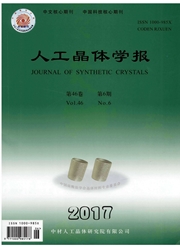

 中文摘要:
中文摘要:
Spin-polarized first-principle was performed to study the structural stability and the electronic states of Cr doped ZnS with the Cr component of 50% in zincblende(ZB), wurtzite(W) and rocksalt(RS) structures under pressure.The results show that the zincblende and wurtzite structures become unstable under low pressures of about4.68 and 9.61 GPa, respectively, but the rocksalt structure can be maintained up to an extremely high pressure of about 32.92 GPa. Both zincblende and wurtzite Zn0.5Cr0.5S display half metallic features under pressure, while rocksalt Zn0.5Cr0.5S exhibits metallic feature. The half metallic features can be ascribed to the stronger interactions between S-3p and Cr-3d states and the metallic feature is due to the higher crystal symmetry of rocksalt Zn0.5Cr0.5S. These results can provide helpful guidance for Cr doped ZnS to be used in spintronic devices.
 英文摘要:
英文摘要:
Spin-polarized first-principle was performed to study the structural stability and the electronic states of Cr doped ZnS with the Cr component of 50% in zincblende (ZB), wurtzite (W) and rocksalt (RS) structures under pressure. The results show that the zincblende and wurtzite structures become unstable under low pressures of about 4.68 and 9.61 GPa, respectively, but the rocksalt structure can be maintained up to an extremely high pressure of about 32.92 GPa. Both zincblende and wurtzite Zno.sCro.5S display half metallic features under pressure, while rocksalt Zno.sCro.sS exhibits metallic feature. The half metallic features can be ascribed to the stronger interactions between S-3p and Cr-3d states and the metallic feature is due to the higher crystal symmetry of rocksalt Zn0.5Cr0.5S. These results can provide helpful guidance for Cr doped ZnS to be used in spintronic devices.
 同期刊论文项目
同期刊论文项目
 同项目期刊论文
同项目期刊论文
 期刊信息
期刊信息
